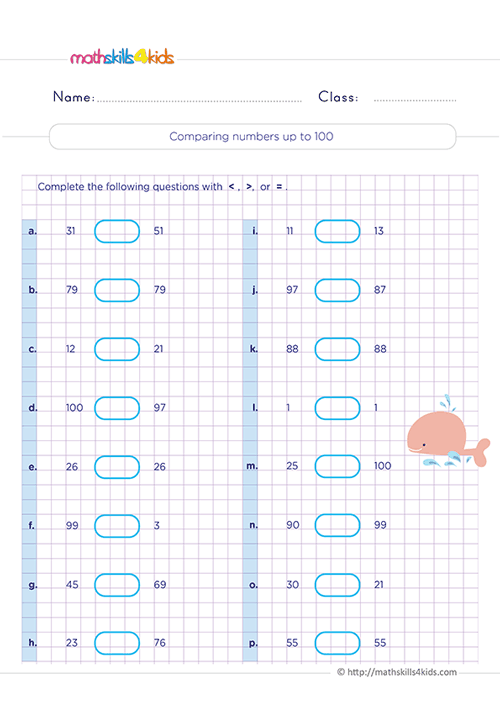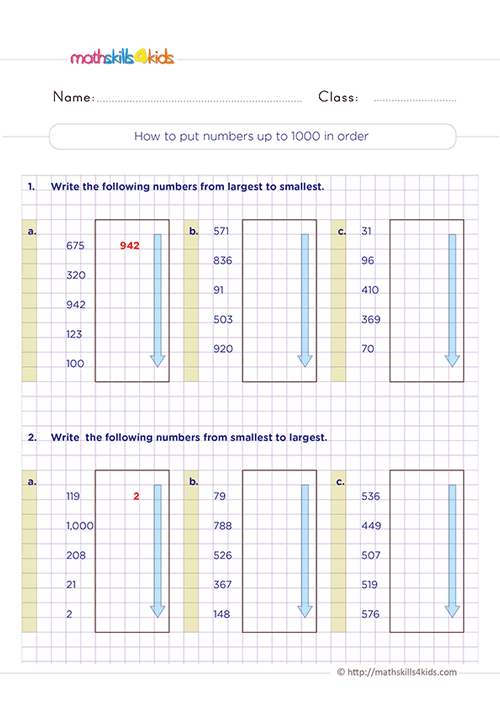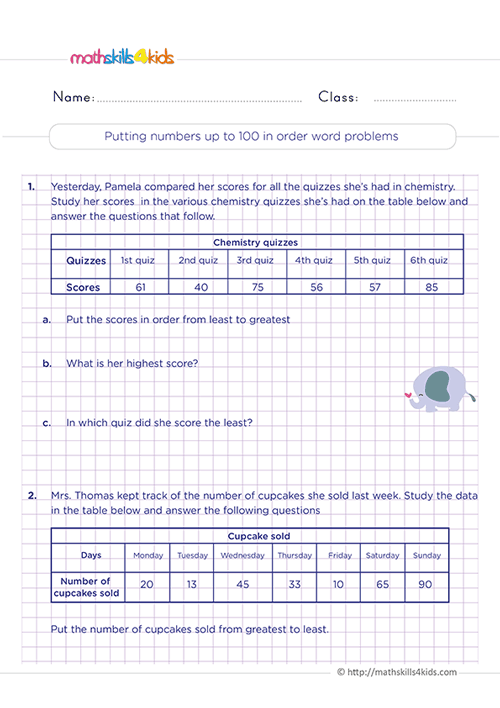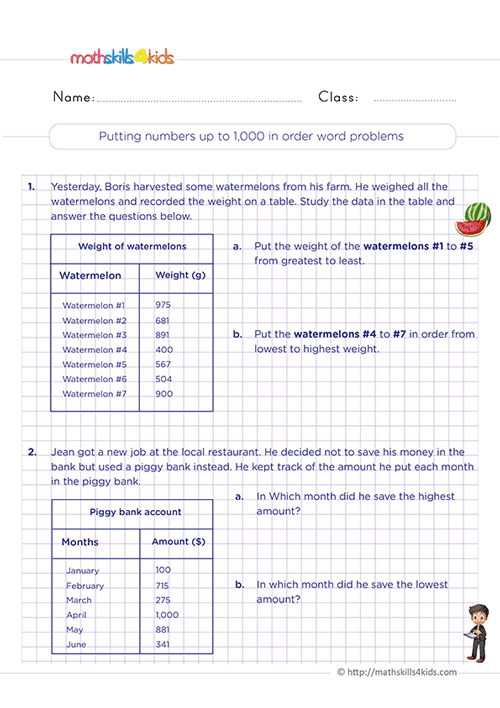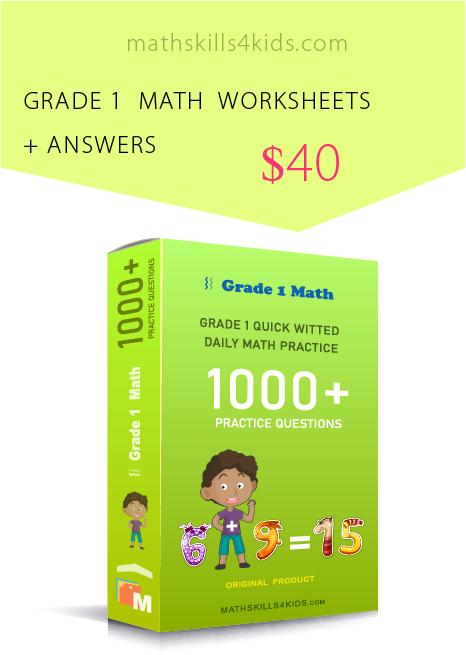2nd Grade math made easy: Comparing and ordering numbers worksheets and activities
Hi there, and welcome to our fun resource about second-grade math made easy! In this article, we'll share with you some fun, engaging worksheets and activities on comparing and ordering numbers.
Here, your child will learn how to compare and order numbers using simple strategies confidently. They will also learn how to use these worksheets and activities to enhance their comparing and ordering numbers skills.
-
Most importantly, we will provide tips and resources for parents and teachers to support second-grade math learning.
Comparing and ordering numbers is an essential skill for second graders, as it helps them develop their number sense, logical thinking, and problem-solving abilities. It also prepares them for more advanced math topics like fractions, decimals, and algebra.
So let's dive in and see how you can use these worksheets and activities to boost your child's math skills and confidence!
Why comparing and ordering numbers is fun and important for second graders
Have you ever wondered why comparing and ordering numbers is fun and important for your second graders? If not, you've come to the right place. Stay engaged and discover why your 2nd graders need comparing and ordering numbers skills in their lives.
Comparing and ordering numbers is a key skill that second graders need to develop in order to understand the value of numbers, the relationship between numbers, and how to use numbers in different contexts. Comparing and ordering numbers helps them to:
- Develop number sense and logical thinking
- Compare quantities and sizes of objects
- Arrange items in a sequence or pattern
- Solve problems involving addition, subtraction, multiplication, and division
- Prepare for more advanced math topics such as fractions, decimals, and algebra
Comparing and ordering numbers can also be much fun for second graders, as they can use different strategies, tools, and games to practice this skill. They can use symbols, words, pictures, manipulatives, number lines, charts, graphs, and more to compare and order numbers differently.
They can also challenge themselves with different difficulty levels, from comparing and ordering two-digit numbers to three-digit numbers.
-
BROWSE THE WEBSITE
-
DOWNLOAD FREE WORKSHEETS
-
-
2nd GRADE MATH TOPICS
- Counting and numbers
- Comparing and ordering
- Reading and writing numbers
- Shape patterns
- Adding of 1-digit numbers
- Subtracting of 1-digit numbers
- Additing 2-digit numbers
- Subtracting within 2-digits
- Up to 3-digit addition
- Subtracting within 3-digit
- Properties of addition & subtaction
- Mixed operations
- Place-value
- Estimating and rounding
- Logical reasoning
- Money Math
- Telling Time
- Data and graphing
- Units of measurement
- 2D shapes
- 3D shapes
- Geometric measurement
- Fractions
- Probability
- Multiplication
- Division
-
-
-
How to use these worksheets and activities to boost your child's math skills and confidence
In this resource, you'll find a variety of worksheets and activities that will help your child practice comparing and ordering numbers in a fun and effective way. Thus, a fantastic way to boost your child's math skills and confidence.
You can use these worksheets and activities as:
- Homework assignments
- Classwork exercises
- Math centers or stations
- Independent practice
- Review or assessment
- Extra practice or enrichment
You can customize these worksheets and activities according to your child's needs, interests, and learning styles. You can choose the ones that suit their level of difficulty, topic of interest, or preferred format. You can also modify them by adding more examples, questions, or challenges.
Here are some of the worksheets and activities that you'll find in this fun resource:
-
Comparing Numbers with Symbols: Greater Than, Less Than, and Equal To
The first thing you need to know about comparing and ordering numbers is how to use symbols to show the relationship between two numbers, whether whole numbers, fractions, decimals, or even negative numbers. These comparing numbers with symbols involve using the greater than (>), less than (<), and equal to (=) signs.
For example, 8 > 5 means that 8 is greater than 5, 5 < 8 means that 5 is less than 8, and 8 = 8 means that 8 is equal to 8.
These symbols are handy for comparing numbers quickly and easily.
This worksheet will help your child practice comparing two-digit numbers using the symbols > (greater than), < (less than), and = (equal to). Your child must look at each pair of numbers and write the correct symbol in the box. For example:
45 _?_ 54
The correct answer is 45 < 54.
This worksheet will help your child understand the value of numbers and how to compare them using symbols. It will also help them prepare for other math skills using these symbols in equations involving addition, subtraction, multiplication, or division.
One way to practice comparing numbers with symbols is to use the worksheets we created for you. They have different difficulty levels, so you can choose the one that suits your child's needs.
Also, the worksheets have pairs of numbers that your child has to compare using the correct symbol. They also have some word problems that require your child to compare numbers in a real-life context.
For example, one of the word problems says: "Clara has 5 apples, and John has 7 apples. Who has more apples? Use a symbol to show your answer." The answer is Clara < John.
In addition, our fun and interactive comparing and ordering numbers activities will keep your child engaged and motivated. These activities include games like bingo, memory, and dominoes, where your child has to match pairs of numbers with the correct symbol.
They also include challenges like puzzles, riddles, and mazes, where your child has to use their logic and reasoning skills to compare numbers and find the solution. For example, one of the puzzles says:
"Fill in the blanks with the correct symbol: 4 _ 6 _ 8 _ 10." The answer is 4 < 6 < 8 < 10.
-
Ordering numbers from least to greatest and greatest to least
The next thing you need to know about comparing and ordering numbers is ordering numbers from least to greatest and greatest to least. This skill helps your child understand the magnitude and value of numbers and how they relate to each other.
To order two-digit numbers from least to greatest or from greatest to least. Your child will have to look at each set of numbers and write them in the correct order. For example:
Order these numbers from least to greatest: 23, 12, 34, 21
The correct answer is: 12, 21, 23, 34.
This worksheet will help your child understand the order of numbers and how to arrange them in a sequence or pattern. It will also help them prepare for using these skills in other math topics, such as skip counting, rounding, estimating, or measuring.
It also helps them organize data and information in a meaningful way. For example, if your child wants to compare the heights of different animals, they can order them from shortest to tallest or from tallest to shortest.
In these worksheets, you'll also find word problems that require your child to order numbers in a real-life context. For example;
One of the word problems says: "There are four kids in a race: Alvin ran 100 meters in 15 seconds, Angelo ran 100 meters in 12 seconds, Sandra ran 100 meters in 18 seconds, and Mara ran 100 meters in 14 seconds. Order the kids from fastest to slowest." The answer is Angelo > Mara > Alvin > Sandra.
In addition, these activities include games like card sorting, number line jumping, and spinner wheeling, where your child has to order sets of numbers correctly.
They also include challenges like crossword puzzles, secret codes, and hidden pictures, where your child has to use their ordering skills to reveal a hidden message or image. For example;
One of the secret codes says: "Order these numbers from least to greatest and write the corresponding letter below each number:
16 - F
9 - C
12 - D
6 - B
18 - G
3 - A
15 - E
The answer is A B C D E F G."
-
Using place value to compare and order numbers up to 1000
Another thing you need to know about comparing and ordering numbers is using place value to compare and order numbers up to 1000.
Place value is the value of each digit in a number based on its position. For example, in the number 123, the 1 is in the hundreds place, the 2 is in the tens place, and the 3 is in the ones place. The value of 1 is 100, the value of 2 is 20, and the value of 3 is 3.
The best way to practice comparing and ordering numbers is using our fun place value worksheets designed just for your 2nd graders. These worksheets have pairs or sets of numbers that your child has to compare or order using place value.
They also have word problems requiring your child to use place value in a real-life context. For example, one of the word problems says: "There are three jars of candy: Jar A has 256 candies, Jar B has 265 candies, and Jar C has 562 candies. Which jar has the most candies? Which jar has the least candies? Use place value to explain your answer."
The answer is that Jar C has the most candies because it has hundreds (5). Jar A has the least candies because it has the least tens (5).
Compare these numbers using place values: 345 and 354
To compare 345 and 354 using place value, you must first look at the hundreds place.
Since both numbers have 3 in the hundreds place, they are equal. Then you have to look at the tens place. Since 345 has 4 in the tens place and 354 has 5 in the tens place, 345 is less than 354. Therefore, 345 < 354.
Hence, the tens place is the deciding factor.
This worksheet will help your child understand the value of each digit in a number and how to use it to compare or order numbers. It will also help them prepare for using these skills in other math topics such as expanded form, standard form, word form, or base ten blocks.
-
Fun games and challenges to practice comparing and ordering numbers
In addition to worksheets, you'll also find some fun games and challenges that will help your child practice comparing and ordering numbers more interactively and engagingly.
You can use these games and challenges as:
- Warm-up or cool-down activities
- Math breaks or transitions
- Partner or group work
- Math games or competitions
- Reward or incentive
You can customize these games and challenges according to your child's needs, interests, and learning styles. You can choose the ones that suit their level of difficulty, topic of interest, or preferred format. You can also modify them by adding more rules, variations, or extensions.
Here are some of the games and challenges that you can use to boost your children's comparing and ordering skills:
- War: This classic card game can be adapted to practice comparing numbers. You'll need a deck of cards with the face cards removed.
Each player gets half of the deck and places it face down. Then, each player flips over one card at a time and compares them using the symbols >, <, or =. The player with the higher card wins both cards and puts them at the bottom of their pile.
If the cards are equal, the players flip over another card and compare them again. The game continues until one player has all the cards or until a time limit is reached.
- Number Line Race: This is a fun game that can be played with a number line (either drawn on paper or the floor) and some dice. You'll need two dice for each player and some markers (such as coins, buttons, or erasers) to represent each player's position on the number line.
Each player starts at zero and rolls both dice. Then, they add the two numbers on the dice and move that many spaces on the number line.
The first player to reach 100 wins. You can also play this game with subtraction (by subtracting the smaller number from the larger number on the dice) or multiplication (by multiplying the two numbers on the dice).
- Place Value Bingo: This is a fun game that can be played with a bingo card (either printed or made by hand) and some chips or counters. You'll need a bingo card for each player with 25 random three-digit numbers up to 1000 in each square.
Then, you'll need a caller who will call out different place value clues such as "a number with 6 hundred", "a number with 4 ones", or "a number with 7 tens".
The players must find a number on their bingo card matching the clue and cover it with a chip or counter. The first player to cover five numbers in a row (horizontally, vertically, or diagonally) wins.
-
Tips and resources for parents and teachers to support second-grade math learning
As a parent or teacher, you need some extra tips and resources to support your second grader's math learning. Here are some tips and resources that will help you make math fun and meaningful for your second grader:
- Encourage your child to use different strategies, tools, and games to practice comparing and ordering numbers.
This will help them develop their number sense, logical thinking, and problem-solving skills.
- Please provide your child with feedback, praise, and encouragement as they practice comparing and ordering numbers.
This will help them build their confidence and motivation in math.
- Connect math to real-life situations and contexts that your child can relate to.
This will help them see the relevance and importance of math in their everyday lives.
- Explore different math topics and concepts related to comparing and ordering numbers, such as fractions, decimals, algebra, geometry, measurement, data, etc.
This will help them expand their math knowledge and skills.
- Use online resources on comparing and ordering numbers, such as websites, apps, videos, podcasts, etc., that offer more worksheets, activities, games, challenges, lessons, tutorials, etc..
This will help them practice more independently and at their own pace.
- Encourage your child to use different strategies, tools, and games to practice comparing and ordering numbers.
Bonus: Find more resources to reinforce comparing and ordering numbers in second Grade here!
We hope you enjoyed this resource on comparing and ordering numbers in second grade! This is an essential topic for building number sense and preparing for more advanced math concepts. If you are looking for more resources to reinforce these skills, here are some web pages with addresses that you can check out:
- Comparing and Ordering Numbers Activities - Saddle Up for 2nd Grade: This blog post has ten fun and engaging activities you can use with your students to practice comparing and ordering numbers using different strategies and representations. You can find it at https://saddleupfor2ndgrade.com/comparing-and-ordering-numbers-activities/
- Teaching the Skill of Comparing Numbers – Mrs. Balius: Teaching Resources to Share: This blog post explains why comparing numbers is important and how to teach it using various activities and games. You can find it at https://www.mrsbalius.com/2020/08/comparing%20numbers.html
- 2nd Grade Ordering Numbers Teaching Resources | TPT: This is a collection of resources from Teachers Pay Teachers that you can use to teach and practice ordering numbers in second grade. You can find it at https://www.teacherspayteachers.com/Browse/Search:2nd%20grade%20ordering%20numbers
Thank you for sharing the links of MathSkills4Kids.com with your loved ones. Your choice is greatly appreciated.
We hope you enjoyed this article about second-grade math made easy!
Comparing and ordering numbers is a fun and essential skill for second graders, and we hope these worksheets and activities will help your child master it quickly and confidently.
Thank you for reading, and happy learning!
-
